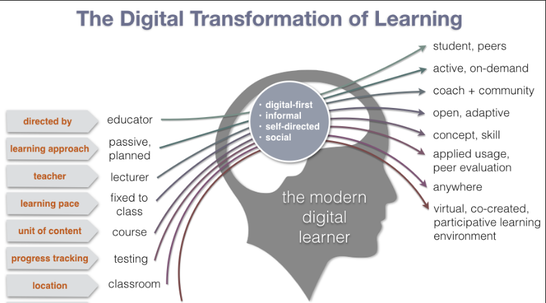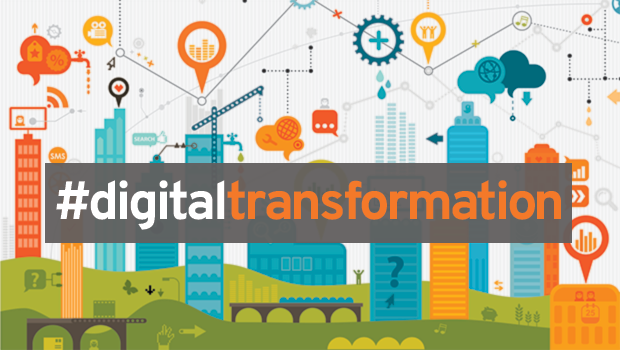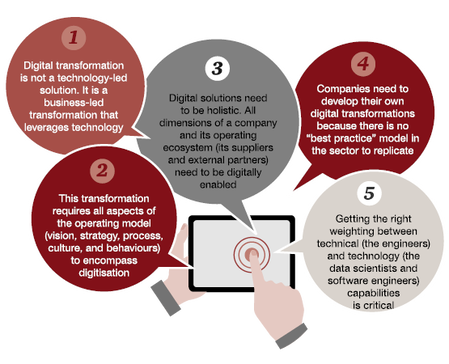- Logistics
- Infrastructure
- Communications
- IT
Source: https://www.scmr.com/article/preparing_the_supply_chain_for_digital_transformation
In all honesty, companies would fare better and reap greater benefits if they create a vision and a comprehensive plan prior to undertaking a digital transformation. A long term road map would need to be outlined and accordingly implemented.
Supply Chain and Digital Transformation
Industry boundaries are blurring and new business models are emerging to help companies succeed in this ever-evolving digitized landscape. Ultimately the strategic goals of a company matter and play a pivotal role in this digitized economy. When creating a roadmap for digital transformation, a company needs to focus on:
- Competitive strategies
- Trends influencing the market
- Customer expectations
- Company outlook
Businesses which apply these approaches to the supply chain transformation are better equipped to utilize the full value that digital technology can provide.
For the supply chain industry, the vision provides a company the necessary assessment of the business and technical requirements and capabilities. It also recognises that supply-chain transformation focuses on both technology as well as operations, hence effectiveness of the transformation depends on the future vision of the supply chain.
Thanks to digitization consumers can now do more research and educate themselves regarding products or services they desire before even engaging with a company. Hence companies in the supply-chain business need to match up with the agility and digital competence at every stage and level. Let us look at some key technologies which will help the supply chain industry:
Real Time Updates
Supply chain managers have more control in providing the customer with transparency, where they can track shipments and products in real-time. They get automatic notifications in case of delays or even issues which might come up. This also helps build consumer loyalty as it increases customer engagement.
Cloud based shipping and tracking technologies provide real time visibility across the supply chain. These tools help track and consolidate all data while eliminating time and resources spent on shipping, receiving, tracking and compiling order data.
Source: https://www.supplychaindigital.com/technology/supply-chain-management-amidst-rapid-digital-transformation
Big data analysis helps guide decisions as the data analytics and reports can keep track of sales patterns, identify cross selling opportunities, eliminate the need for guesswork and even resolve potential issues before they escalate. This technology is now simple and user-friendly which means navigation and interpretation of information has never been simpler and clearer.
Automation
Automation of processes not only helps eliminate human error but also saves on manpower and skills. Instead of manually updating data or spreadsheets, employees can focus on other more sensitive areas which would help companies maximize profits. Software applications can now update the necessary data in real time.
E-Commerce
E-commerce helps sellers sell directly to the end consumer and sometimes this can pose a threat to supply chain intermediaries. However if the companies adapt and find a way to add value in the face of it, they will be able to increase their market reach and client database.
For example, drone deliveries are gaining popularity and are being used by Amazon Air to ensure customers get their parcels quicker.
All companies in the supply-chain have something to gain from digital transformation provided they are open and willing to adapt.
The transformation into a digital supply chain is a process which yields significant performance improvements. Combining digital capabilities, targeting specialist recruitment, implementation of the changes and creating an agile working environment are crucial for rapid development.
In order to meet the challenges of today’s digital economy, where customers demand quicker and more personalized services, the organizations fundamental business process with the digital supply chain needs the following enablers:
Customer Centricity
Customer engagement and centricity is vital for any business to survive. It must be integrated with digital supply chain capabilities to serve segments of the business. Automation of processes helps achieve this along with real-time updates. Focus needs to remain on customer first.
Forecasting and accurate analysis helps capture the necessary demographic and increase profits. Marketing via social media, mails and texts are easier with the predictive algorithms. These improved processes enable companies better manage collaborations and more effectively handle bulk orders.
Predictive Analysis
Digital technology makes it possible to address issues before they become major concerns. Machines can be serviced and fixed before they break-down. Shipments can be routed through areas with no traffic or threats.
The internet of things sensor data and make it possible for companies to benefit from their analysis. This would only be beneficial if companies integrate and use these technologies as part of their core processes.
Visibility
Automation, responsiveness and individualization is required to succeed in this digital world. Real-time visibility goes a long way to help mirror the digital side of business. Everything is monitored:
- Movement of goods
- Transit
- Demand signals
- Relevant data
- Sale systems
Modern supply chain extends beyond the organization and the need for flexible coordination and collaboration across business networks is important to improve sustainability and streamline transactions.
Source: https://www.digitalistmag.com/digital-supply-networks/2018/04/11/4-supply-chain-strategies-to-drive-digital-transformation-06079557
Today, technologies have enabled organizations to transform their existing supply chain capabilities and be more flexible, agile, open and collaborative. They make it possible for companies to transform by employing analytics, artificial intelligence, robotics, the Internet of things and many more advanced technologies to collect and process the necessary information to aid business development.
A supply chain digital transformation is about establishing a balance with digital applications, services, cost and processes to drive operational excellence. The burst of innovation has given the market technologies which enable companies to enhance their practices and make greater improvements in supply-chain performance.
If you would like to discuss this further you can contact our App Scoop mobile app developers on https://app-scoop.com/contact-us.html.















